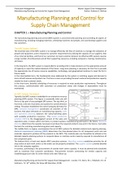Samenvatting
Summary Chapters Book Production Management
- Instelling
- Tilburg University (UVT)
Summary of the chapters covered for Production Management in the book of Jacobs (2010), Manufacturing Planning and Control for Supply Chain Management.
[Meer zien]





